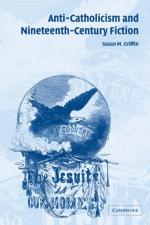|
This section contains 7,707 words (approx. 26 pages at 300 words per page) |

|
SOURCE: "Some Themes of Counter-Subversion: An Analysis of Anti-Masonic, Anti-Catholic, and Anti-Mormon Literature," in From Homicide to Slavery: Studies in American Culture, Oxford University Press, 1986, pp. 137-154.
In this essay, originally published in 1960, Davis analyzes various themes of anti-Catholic, anti-Masonic, and anti-Mormon literature in nineteenth-century America, suggesting that it tended to subvert the established order it claimed to protect by liberating certain irrational impulses against an imagined enemy.
During the second quarter of the nineteenth century, when danger of foreign invasion appeared increasingly remote, Americans were told by various respected leaders that Freemasons had infiltrated the government and had seized control of the courts, that Mormons were undermining political and economic freedom in the West, and that Roman Catholic priests, receiving instructions from Rome, had made frightening progress in a plot to subject the nation to popish despotism. This fear of internal subversion was channeled into a number...
|
This section contains 7,707 words (approx. 26 pages at 300 words per page) |

|


